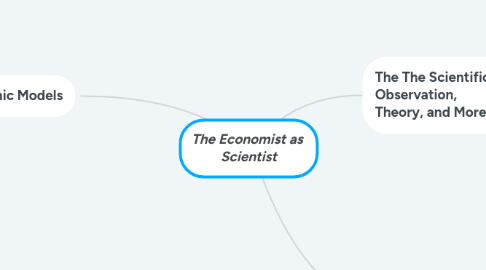
1. Economic Models
1.1. Our First Model: The Circular-Flow Diagram
1.1.1. Circular-flow diagram.
1.1.1.1. Visual model of the economy
1.1.1.2. Shows how dollars flow through markets among households and firms
1.1.2. Decision markers
1.1.2.1. Firms
1.1.2.1.1. Firms produce goods and services using inputs, such as labor, land, and capital (buildings and machines). These inputs are called the factors of production.
1.1.2.2. Households
1.1.2.2.1. Households own the factors of production and consume all the goods and services that the firms produce.
1.1.3. Markets
1.1.3.1. Markets for goods and services,
1.1.3.1.1. Households are buyers, and firms are sellers.
1.1.3.1.2. In particular, households buy the output of goods and services that firms produce.
1.1.3.2. Markets for the fac- tors of production
1.1.3.2.1. Households are sellers, and firms are buyers.
1.1.3.2.2. households provide the inputs that firms use to produce goods and services.
1.2. Our Second Model: The Production Possibilities Frontier
1.2.1. Efficient levels of production
1.2.1.1. A graph that shows the various combinations of output—in this case, cars and computers—that the economy can possibly produce given the available factors of production and the available production technology that firms use to turn these factors into output.
1.2.1.2. If the economy is getting all it can from the scarce resources it has available.
1.2.1.3. Points on (rather than inside) the produc- tion possibilities frontier represent efficient levels of production.
1.2.1.4. The production possibilities frontier shows one trade-off that society faces. Once we have reached the efficient points on the frontier, the only way of producing more of one good is to produce less of the other.
1.2.2. Inefficient levels of production
1.2.2.1. Points inside production possibilities frontier
1.2.2.2. Opportunity cost of one good: Give up the other good
1.2.2.3. Bowed out production possibilities frontier
2. The The Scientific Method: Observation, Theory, and More Observation
2.1. Observation
2.2. Theory
2.3. Conducting experiments
2.3.1. Difficult /Impossible
2.4. Observation
2.4.1. Close attention to natural experiments -history
3. The Role of Assumptions
3.1. Assumptions
3.1.1. Assumptions can simplify the complex world and make it easier to understand.
3.1.1.1. Ex: To study the effects of international trade, we might assume that the world consists of only two countries and that each country produces only two goods. In reality, there are numerous countries, each of which produces thousands of different types of goods.
3.1.2. focus our thinking on the essence of the problem.
3.2. Different assumptions
3.2.1. to answer different ques- tions.
3.2.2. Short-run effects
3.2.3. Long-run effects
